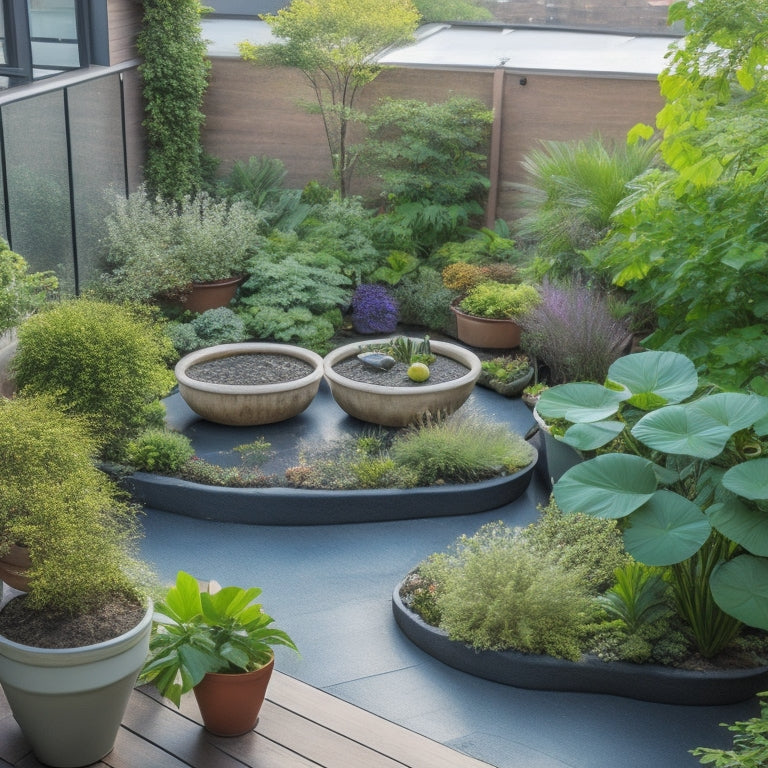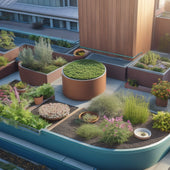
Why Rooftop Gardens Require Special Maintenance Care
Share
When you maintain a rooftop garden, you'll encounter unique challenges that demand special attention. The combination of structural limitations, extreme weather conditions, and restricted access creates an environment that requires tailored strategies. You'll need to select resilient plants, guarantee efficient irrigation, and implement reliable drainage to prevent waterlogging. Weather resistance and protection are also vital, as are specialized pruning and training techniques to promote healthy growth and visual appeal. As you navigate these complexities, you'll uncover the significance of precision and focus on detail in rooftop garden maintenance. Ahead, you'll discover the keys to overcoming these challenges.
Unique Challenges of Rooftop Gardens
Rooftop gardens present a distinct set of challenges that you won't typically encounter with traditional ground-level gardens, including structural limitations, extreme weather conditions, and restricted access. As a rooftop gardener, you'll need to carefully select plants that can thrive in these unique conditions.
This means choosing varieties that are tolerant of high winds, intense sunlight, and temperature fluctuations. Additionally, you'll need to make sure that your plant selection is compatible with the structural support of your rooftop, taking into account weight limits and potential drainage issues.
Another critical aspect of rooftop garden maintenance is pest control. You'll need to be vigilant about monitoring for pests that can thrive in rooftop environments, such as aphids, whiteflies, and spider mites.
Seasonal changes can also impact your rooftop garden, with extreme weather conditions like hail, strong winds, and frost requiring special care. By understanding these unique challenges and taking proactive steps to address them, you can create a thriving and resilient rooftop garden that brings beauty and serenity to your outdoor space.
Soil and Drainage Considerations
Proper soil selection and drainage planning are essential for ensuring your rooftop garden's long-term health and stability, as they directly impact the roots of your plants and the structural integrity of your building. When choosing a soil composition, you'll want to select a mix that's specifically designed for green roofs, taking into account factors like weight, drainage, and aeration. This will help prevent waterlogging and guarantee your plants receive the oxygen they need to thrive.
Drainage solutions are also vital, as they address waterproofing concerns and prevent water from accumulating on your rooftop. You'll want to implement a reliable drainage system that can handle excess water, such as a layer of aggregate or a drainage mat. This won't only protect your building's structure but also provide a healthy environment for your plants to grow.
Irrigation System Maintenance Needs
You'll need to make certain your irrigation system is working efficiently to supply your rooftop garden with the right amount of water, as inadequate or excessive watering can compromise plant health and structural integrity. Water efficiency is essential in rooftop gardens, where waterlogging can lead to weight issues and structural damage.
A well-maintained irrigation system guarantees that plants receive the right amount of water, promoting healthy growth and minimizing waste.
Drip irrigation systems are particularly effective in rooftop gardens, as they deliver water directly to the roots, reducing evaporation and runoff. This targeted approach also encourages healthy root development, which is vital for plant health.
Regularly inspect your irrigation system to make sure that emitters and drippers are clogged-free and functioning correctly. Check for leaks, and adjust the system as needed to prevent overwatering.
Weather Resistance and Protection
Every rooftop garden requires a robust weather resistance and protection strategy to shield it from harsh environmental elements, ensuring the longevity of your plants and structure. As a rooftop garden owner, you must consider the impact of weather conditions on your garden's structural integrity and plant health. Harsh weather conditions like heavy rainfall, intense sunlight, and strong winds can cause significant damage if not addressed properly.
To mitigate these effects, you can implement various weather resistance and protection measures. Here are some key considerations:
| Weather Element | Protection Measure |
|---|---|
| Rain and Moisture | Waterproofing solutions, drainage systems |
| UV Radiation | UV protection coatings, shading systems |
| Wind | Wind-resistant plant selection, structural reinforcements |
| Temperature Extremes | Insulation, climate-controlled greenhouses |
Specialized Pruning and Training
As your rooftop garden's unique microclimate and spatial constraints require tailored care, regular specialized pruning and training of your plants are essential to maintain their health, optimize growth, and enhance overall aesthetics.
You'll need to adopt precise pruning techniques to control plant size, promote air circulation, and prevent overcrowding. This might involve thinning out branches, pinching off tips, or reducing foliage to let in more sunlight.
Additionally, you'll need to train your plants to grow vertically or horizontally, depending on the available space and desired visual effect. This can be achieved through the use of trellises, stakes, or espaliers.
By doing so, you'll create a balanced and visually appealing rooftop garden that thrives in its unique environment. Regular pruning and training will also help prevent pest and disease issues, reducing the need for pesticides and fungicides.
Frequently Asked Questions
Can Rooftop Gardens Be Used as Outdoor Living Spaces?
You can definitely use your rooftop garden as an outdoor living space, perfect for rooftop gatherings and outdoor relaxation. Imagine hosting rooftop garden parties amidst lush greenery, transforming your urban oasis into a serene escape.
Are Rooftop Gardens More Prone to Pest Infestations?
You'll find that rooftop gardens are more vulnerable to pest infestations due to their unique environment, making targeted pest control essential; careful plant selection, such as pest-resistant species, can also help mitigate infestation risks.
Do Rooftop Gardens Require Special Insurance Coverage?
"Your rooftop garden is like a delicate soufflé, requiring precise care. You'll need specialized insurance coverage to protect against unexpected losses, as maintenance costs can skyrocket if not properly addressed, leaving you financially exposed."
Can Rooftop Gardens Be Installed on Old or Historic Buildings?
When considering rooftop gardens on old or historic buildings, you'll need to address structural concerns and preservation requirements, ensuring the roof can support added weight, and implementing effective drainage solutions to prevent damage.
Are Rooftop Gardens a Good Option for Urban Beekeeping?
"As you consider urban beekeeping, rooftop gardens are a sweet spot, literally! They're a hive of activity, fostering urban agriculture and environmental benefits, providing a buzzworthy opportunity to support local ecosystems and pollinators."
Related Posts
-

How Much Do Concrete Planters Weigh
When creating a concrete planter, you'll need to take into account the weight implications of your design. The type a...
-

How Much Do Concrete Planters Weigh
When creating a concrete planter, you'll need to take into account the weight implications of your design. The type a...
-

How Much Do Concrete Planters Weigh
When creating a concrete planter, you'll need to take into account the weight implications of your design. The type a...
-

How Much Do Concrete Planters Weigh
When creating a concrete planter, you'll need to take into account the weight implications of your design. The type a...
-

How Much Do Concrete Planters Weigh
When creating a concrete planter, you'll need to take into account the weight implications of your design. The type a...
-

How Much Do Concrete Planters Weigh
When creating a concrete planter, you'll need to take into account the weight implications of your design. The type a...
-

How Much Do Concrete Planters Weigh
When creating a concrete planter, you'll need to take into account the weight implications of your design. The type a...
-

How Much Do Concrete Planters Weigh
When creating a concrete planter, you'll need to take into account the weight implications of your design. The type a...
-

How Much Do Concrete Planters Weigh
When creating a concrete planter, you'll need to take into account the weight implications of your design. The type a...
-

How Much Do Concrete Planters Weigh
When creating a concrete planter, you'll need to take into account the weight implications of your design. The type a...
-

How Much Do Concrete Planters Weigh
When creating a concrete planter, you'll need to take into account the weight implications of your design. The type a...
-

How Much Do Concrete Planters Weigh
When creating a concrete planter, you'll need to take into account the weight implications of your design. The type a...
-

How Much Do Concrete Planters Weigh
When creating a concrete planter, you'll need to take into account the weight implications of your design. The type a...
-

How Much Do Concrete Planters Weigh
When creating a concrete planter, you'll need to take into account the weight implications of your design. The type a...
-

How Much Do Concrete Planters Weigh
When creating a concrete planter, you'll need to take into account the weight implications of your design. The type a...
-

How Much Do Concrete Planters Weigh
When creating a concrete planter, you'll need to take into account the weight implications of your design. The type a...
-

How Much Do Concrete Planters Weigh
When creating a concrete planter, you'll need to take into account the weight implications of your design. The type a...
-

How Much Do Concrete Planters Weigh
When creating a concrete planter, you'll need to take into account the weight implications of your design. The type a...
-

How Much Do Concrete Planters Weigh
When creating a concrete planter, you'll need to take into account the weight implications of your design. The type a...
-

How Much Do Concrete Planters Weigh
When creating a concrete planter, you'll need to take into account the weight implications of your design. The type a...
-

How Much Do Concrete Planters Weigh
When creating a concrete planter, you'll need to take into account the weight implications of your design. The type a...
-

How Much Do Concrete Planters Weigh
When creating a concrete planter, you'll need to take into account the weight implications of your design. The type a...
-

How Much Do Concrete Planters Weigh
When creating a concrete planter, you'll need to take into account the weight implications of your design. The type a...
-

How Much Do Concrete Planters Weigh
When creating a concrete planter, you'll need to take into account the weight implications of your design. The type a...
-

How Much Do Concrete Planters Weigh
When creating a concrete planter, you'll need to take into account the weight implications of your design. The type a...
-

How Much Do Concrete Planters Weigh
When creating a concrete planter, you'll need to take into account the weight implications of your design. The type a...
-

How Much Do Concrete Planters Weigh
When creating a concrete planter, you'll need to take into account the weight implications of your design. The type a...
-

How Much Do Concrete Planters Weigh
When creating a concrete planter, you'll need to take into account the weight implications of your design. The type a...
-

How Much Do Concrete Planters Weigh
When creating a concrete planter, you'll need to take into account the weight implications of your design. The type a...
-

3 Best Roof Garden Drainage Solutions for Planters
When designing your roof garden, you'll want to implement a planter drainage system that guarantees water flows freel...
-

3 Best Roof Garden Drainage Solutions for Planters
When designing your roof garden, you'll want to implement a planter drainage system that guarantees water flows freel...
-

3 Best Roof Garden Drainage Solutions for Planters
When designing your roof garden, you'll want to implement a planter drainage system that guarantees water flows freel...
-

3 Best Roof Garden Drainage Solutions for Planters
When designing your roof garden, you'll want to implement a planter drainage system that guarantees water flows freel...
-

3 Best Roof Garden Drainage Solutions for Planters
When designing your roof garden, you'll want to implement a planter drainage system that guarantees water flows freel...
-

3 Best Roof Garden Drainage Solutions for Planters
When designing your roof garden, you'll want to implement a planter drainage system that guarantees water flows freel...
-

3 Best Roof Garden Drainage Solutions for Planters
When designing your roof garden, you'll want to implement a planter drainage system that guarantees water flows freel...
-

3 Best Roof Garden Drainage Solutions for Planters
When designing your roof garden, you'll want to implement a planter drainage system that guarantees water flows freel...
-

3 Best Roof Garden Drainage Solutions for Planters
When designing your roof garden, you'll want to implement a planter drainage system that guarantees water flows freel...
-

3 Best Roof Garden Drainage Solutions for Planters
When designing your roof garden, you'll want to implement a planter drainage system that guarantees water flows freel...
-

3 Best Roof Garden Drainage Solutions for Planters
When designing your roof garden, you'll want to implement a planter drainage system that guarantees water flows freel...
-

3 Best Roof Garden Drainage Solutions for Planters
When designing your roof garden, you'll want to implement a planter drainage system that guarantees water flows freel...
-

3 Best Roof Garden Drainage Solutions for Planters
When designing your roof garden, you'll want to implement a planter drainage system that guarantees water flows freel...
-

5 Tips for Shaded Area Gardening Success
To turn your shaded areas into thriving gardens, start by selecting shade-tolerant crops like leafy greens and herbs,...
-

5 Tips for Shaded Area Gardening Success
To turn your shaded areas into thriving gardens, start by selecting shade-tolerant crops like leafy greens and herbs,...
-

5 Tips for Shaded Area Gardening Success
To turn your shaded areas into thriving gardens, start by selecting shade-tolerant crops like leafy greens and herbs,...
-

5 Tips for Shaded Area Gardening Success
To turn your shaded areas into thriving gardens, start by selecting shade-tolerant crops like leafy greens and herbs,...
-

5 Tips for Shaded Area Gardening Success
To turn your shaded areas into thriving gardens, start by selecting shade-tolerant crops like leafy greens and herbs,...
-

5 Tips for Shaded Area Gardening Success
To turn your shaded areas into thriving gardens, start by selecting shade-tolerant crops like leafy greens and herbs,...
-

5 Tips for Shaded Area Gardening Success
To turn your shaded areas into thriving gardens, start by selecting shade-tolerant crops like leafy greens and herbs,...
-

5 Tips for Shaded Area Gardening Success
To turn your shaded areas into thriving gardens, start by selecting shade-tolerant crops like leafy greens and herbs,...
-

5 Tips for Shaded Area Gardening Success
To turn your shaded areas into thriving gardens, start by selecting shade-tolerant crops like leafy greens and herbs,...
-

5 Tips for Shaded Area Gardening Success
To turn your shaded areas into thriving gardens, start by selecting shade-tolerant crops like leafy greens and herbs,...
-

5 Tips for Shaded Area Gardening Success
To turn your shaded areas into thriving gardens, start by selecting shade-tolerant crops like leafy greens and herbs,...
-

5 Tips for Shaded Area Gardening Success
To turn your shaded areas into thriving gardens, start by selecting shade-tolerant crops like leafy greens and herbs,...
-

5 Tips for Shaded Area Gardening Success
To turn your shaded areas into thriving gardens, start by selecting shade-tolerant crops like leafy greens and herbs,...
-

5 Tips for Shaded Area Gardening Success
To turn your shaded areas into thriving gardens, start by selecting shade-tolerant crops like leafy greens and herbs,...
-

5 Tips for Shaded Area Gardening Success
To turn your shaded areas into thriving gardens, start by selecting shade-tolerant crops like leafy greens and herbs,...
-

5 Tips for Shaded Area Gardening Success
To turn your shaded areas into thriving gardens, start by selecting shade-tolerant crops like leafy greens and herbs,...
-

5 Tips for Shaded Area Gardening Success
To turn your shaded areas into thriving gardens, start by selecting shade-tolerant crops like leafy greens and herbs,...
-

5 Tips for Shaded Area Gardening Success
To turn your shaded areas into thriving gardens, start by selecting shade-tolerant crops like leafy greens and herbs,...
-

5 Tips for Shaded Area Gardening Success
To turn your shaded areas into thriving gardens, start by selecting shade-tolerant crops like leafy greens and herbs,...
-

5 Tips for Shaded Area Gardening Success
To turn your shaded areas into thriving gardens, start by selecting shade-tolerant crops like leafy greens and herbs,...


